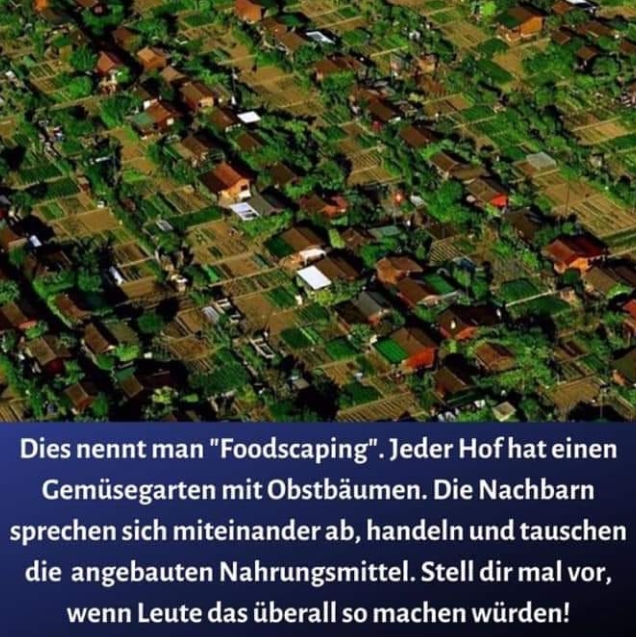In an often shared sharepic on Facebook, you can see an allotment settlement with vegetables and growing areas in the gardens. Below it is the text: “This is called “foodscaping”. The neighbors talk to each other, trade and exchange.”
What seems like a small version of a market economy has actually become common in many, especially small, communities.
Strictly speaking, the English word “foodscaping” actually refers to a hybrid between farming and landscaping. Front gardens or green areas are planted with edible plant varieties. For example, instead of a birch tree, an apple tree is planted or instead of a normal hedge, tomato or elderberry bushes are planted.

In addition to its appearance, each plant should above all provide an effective benefit, i.e. provide food for the residents.
In the sharepic described above, it is stated that the neighbors exchange and coordinate with each other.
Although this would theoretically be possible, it is usually common practice for each neighbor in allotment gardens to plant the basic vegetables themselves and only the unusual or particularly difficult to grow varieties are resold or exchanged.
Foodscaping was particularly common in cities and rural areas during times of economic crisis and war to combat famine, as food supplies in many areas of the country were either destroyed by war unrest or severely affected by economic crises, making food prices unaffordable.
[mk_ad]
What are benefits?
In fact, foodscaping has many advantages; the resident knows exactly where their food comes from and under what circumstances they grew it. The resident also decides on the use of fertilizer or weed killer. Theoretically, the range in a garden can be from purely organic with no additives to fully supported. The resident is his own local supplier and at a very low price compared to supermarket products.
What are disadvantages?
Foodscaping requires space and, above all, a garden (especially for root and nightshade plants such as pumpkins and potatoes).
This means that residents who have an apartment without a garden are dependent on space being made available in the city itself where they can grow their own. In addition, useful plants require more care than normal gardens or parks. Daily water supply (especially in hot summers) and sunlight are necessary to keep the vegetables alive. The occurrence of specific pests can often only be dealt with using expensive means.
The principle of seasonal vegetables also applies: While globalization guarantees that almost every vegetable is available at any time of the year, growing your own food limits the supply to seasonal vegetables, which have to be stored in-house after the harvest. In addition, not all fruits and vegetables can be kept for longer without freezing, such as tomatoes or strawberries.
Conclusion
In summary, foodscaping is a great principle for ensuring your own supplies in times of crisis and, above all, for controlling the origin of the products yourself. On the other hand, an unusual fruit and vegetable garden requires a lot of care and attention. The range is also limited to seasonal products and requires space and processing options after the harvest in order not to spoil.
Author: Alexander Herberstein; Article image: Shutterstock / By Maxim Komissarov
Notes:
1) This content reflects the current state of affairs at the time of publication. The reproduction of individual images, screenshots, embeds or video sequences serves to discuss the topic. 2) Individual contributions were created through the use of machine assistance and were carefully checked by the Mimikama editorial team before publication. ( Reason )

